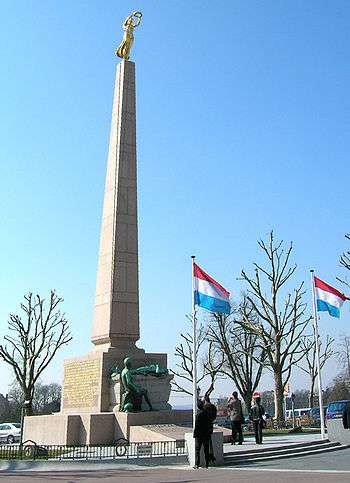Gëlle Fra
Coordinates: 49°36′34″N 06°07′44″E / 49.60944°N 6.12889°E

The Monument of Remembrance (French: Monument du souvenir), usually known by the nickname of the Gëlle Fra (Luxembourgish for 'Golden Lady'), is a war memorial in Luxembourg City, in southern Luxembourg. It is dedicated to the thousands of Luxembourgers who volunteered for service in the armed forces of the Allied Powers during both World Wars and the Korean War.
The Gëlle Fra is situated in Constitution Square, in the Ville Haute quarter of central Luxembourg City.
Description
The centrepiece of the monument is a 21-metre-tall granite obelisk. Atop of the obelisk stands a gilded bronze statue representing Nike, goddess of victory, or "Queen of Freedom" (Friddenskinnigin in Luxembourgish),[1] holding out a laurel wreath as if placing it upon the head of the nation. At the foot of the obelisk are two (ungilded) bronze figures, representing those Luxembourgish soldiers that volunteered to serve for France; one lies at the base of the statue, having died in service of his country, whilst the other sits, mourning his dead compatriot.
The sculptor of the three bronze figures was Claus Cito, a native Luxembourger. The model for the Gëlle Fra is unknown. The monument was opened in 1923.

The inscriptions at the base of the monument include one in French, over the name of Foch, Marshal of France, Commander-in-Chief of Allied Forces, that honours the Luxembourgeois soldiers who took part in the !914-18 war, on the battlefields of the Marne, the Aisne and the Somme, and in Artois, Champagne and at Verdun.
History
First World War

During the First World War, Luxembourg pledged itself to neutrality, but was occupied by Germany, which justified its actions by citing military necessity.[2] However, most Luxembourgers did not believe Germany's good intentions, fearing that Germany would annex their country in the event of a German victory; these claims were substantiated by Bethmann Hollweg's Septemberprogramm.[3]
Although Luxembourgers left under German occupation at home could do little to aid the Allies, those overseas, outside Germany's control, could volunteer to serve against Germany. In total, 3,700 Luxembourgian nationals served in the French army, of whom, 2,000 died.[4] As Luxembourg's pre-war population was only 266,000,[5] this death toll amounted to more than 1% of the entire national population, which is a relatively greater percentage than many combatant nations (see: World War I casualties).
The monument aroused public controversy at the time it was proposed and installed. Opposition had come from the conservative Catholic majority of citizens, and at the inauguration ceremony Grand Duchess Charlotte and the Bishop of Luxembourg were absent.[6]
World War II and after

When Luxembourg was occupied by Nazi forces in World War II, the Germans dismantled the memorial on 21 October 1940. Several portions of the memorial were rescued, and after the war, the monument was partially restored. The Gëlle Fra herself however remained unaccounted for until January 1980 when she was found hidden beneath the main stand of the national football stadium. Later additions were made to honor Luxembourger forces who had served in World War II and the Korean War.

The monument was not fully reconstructed and restored to its original design until 1984 and then finally unveiled to the public in the presence of Grand Duke Jean on 23 June 1985, Luxembourg's national holiday.
The statue of the gilded lady was removed from the obelisk and exhibited at the entrance of the Luxembourg pavilion of the Expo 2010 world exhibition in Shanghai.[7]
"Gëlle Fra 2"
In 2001, a controversial version of the monument, showing the statue as visibly pregnant and with a different inscription, was created by Sanja Iveković and erected nearby.[8] Named as "Lady Rosa of Luxembourg", it is now in Luxembourg's Museum of Modern Art.
Gallery
 Gëlle Fra lowered by crane from the obelisk, March 2010, for removal to Expo 2010, Shanghai
Gëlle Fra lowered by crane from the obelisk, March 2010, for removal to Expo 2010, Shanghai Gëlle Fra removed from the obelisk, for Luxembourg pavilion at the Expo 2010, Shanghai
Gëlle Fra removed from the obelisk, for Luxembourg pavilion at the Expo 2010, Shanghai- "Gëlle Fra 2": Lady Rosa of Luxembourg exhibited in Luxembourg City, 2001
- "Lady Rosa of Luxembourg" by Sanja Ivekovic at the Museum of Modern Art, 2012
- One of the inscriptions on the side of the memorial
Footnotes
- ↑ Luxembourg's Two Golden Ladies
- ↑ Speech by Bethmann Hollweg to the German Reichstag (in German), 4 August 1914
- ↑ (German) Septemberprogramm des Reichskanzlers Theobald von Bethmann-Hollweg. 9 September 1914. Retrieved on 2006-07-27.
- ↑ "'National Museum of Military History in Diekirch, Luxembourg'". Retrieved 2011-09-21.
- ↑ Lahmeyer, Jan. "Luxembourg: Country population". Retrieved 2006-07-27.
- ↑ Enrico Lunghi, Since History Is Always Written by Men …
- ↑ "Reise nach Shanghai: Gëlle Fra wird vom Sockel geholt." Wort.lu, 2010-02-25 15:03, Version of 2010-02-25 16:03. (de)
- ↑ Enrico Lunghi, Since History Is Always Written by Men …
See also
 Media related to Gëlle Fra at Wikimedia Commons
Media related to Gëlle Fra at Wikimedia Commons
References
- (French)/(German) German occupation of Luxembourg. GWPDA, 21 May 1998. Retrieved on 2006-07-27.
External links
- Monument du Souvenir - 'Gëlle Fra': inscriptions with translations from French to English
- Luxembourg's Two Golden Ladies